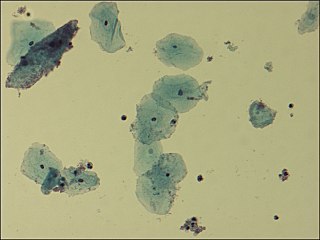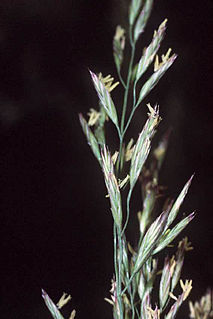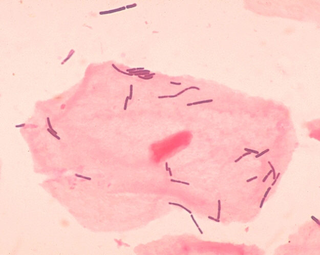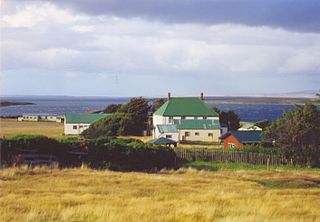
Trichomoniasis (trich) is an infectious disease caused by the parasite Trichomonas vaginalis. About 70% of women and men do not have symptoms when infected. When symptoms do occur they typically begin 5 to 28 days after exposure. Symptoms can include itching in the genital area, a bad smelling thin vaginal discharge, burning with urination, and pain with sex. Having trichomoniasis increases the risk of getting HIV/AIDS. It may also cause complications during pregnancy.

Gardnerella is a genus of Gram-variable-staining facultative anaerobic bacteria of which Gardnerella vaginalis is the only species. The organisms are small non-spore-forming, nonmotile coccobacilli.

Trichomonas vaginalis is an anaerobic, flagellated protozoan parasite and the causative agent of trichomoniasis. It is the most common pathogenic protozoan infection of humans in industrialized countries. Infection rates in men and women are similar but women are usually symptomatic, while infections in men are usually asymptomatic. Transmission usually occurs via direct, skin-to-skin contact with an infected individual, most often through vaginal intercourse. The WHO has estimated that 160 million cases of infection are acquired annually worldwide. The estimates for North America alone are between 5 and 8 million new infections each year, with an estimated rate of asymptomatic cases as high as 50%. Usually treatment consists of metronidazole and tinidazole.

Totiviridae is a family of double-stranded RNA viruses. Giardia lamblia, leishmania, trichomonas vaginalis, and fungi serve as natural hosts. The name of the group derives from Latin toti which means undivided or whole. There are currently 28 species in this family, divided among 5 genera.

Festuca (fescue) is a genus of flowering plants belonging to the grass family Poaceae. They are evergreen or herbaceous perennial tufted grasses with a height range of 10–200 cm (4–79 in) and a cosmopolitan distribution, occurring on every continent except Antarctica. The genus is closely related to ryegrass (Lolium), and recent evidence from phylogenetic studies using DNA sequencing of plant mitochondrial DNA shows that the genus lacks monophyly. As a result, plant taxonomists have moved several species, including the forage grasses tall fescue and meadow fescue, from the genus Festuca into the genus Lolium, or alternatively into the segregate genus Schedonorus.

Bifidobacteriales is an order of bacteria, in the subclass of Actinobacteridae.

Vaginal flora, vaginal microbiota or vaginal microbiome are the microorganisms that colonize the vagina. They were discovered by the German gynecologist Albert Döderlein in 1892 and are part of the overall human flora. The amount and type of bacteria present have significant implications for a woman's overall health. The primary colonizing bacteria of a healthy individual are of the genus Lactobacillus, such as L. crispatus, and the lactic acid they produce is thought to protect against infection by pathogenic species.

Festuca rubra is a species of grass known by the common name red fescue or creeping red fescue. It is widespread across much of the Northern Hemisphere and can tolerate many habitats and climates. It is best adapted to well-drained soils in cool, temperate climates; it prefers shadier areas and is often planted for its shade tolerance. Wild animals browse it, but it has not been important for domestic forage due to low productivity and palatability. It is also an ornamental plant for gardens.

Festuca caldasii is a species of grass in the family Poaceae. It is found only in Ecuador.

Festuca chimborazensis is a species of grass in the family Poaceae. It is found only in Ecuador.

Festuca densipaniculata is a species of grass. It is found only in Ecuador.

Festuca flacca is a species of grass in the family Poaceae. It is found only in Ecuador.

Festuca glumosa is a species of grass in the family Poaceae. It is found only in Ecuador.

Festuca parciflora is a species of grass in the family Poaceae. It is found only in Ecuador.

Festuca sodiroana is a species of grass in the family Poaceae.Its habitat spans from southern Ecuador to northern Colombia. It grows at an altitude of 2600–3800 meters in forest clearings and margins of brooks or rivers.

Erebia epistygne, the spring ringlet, is a species of butterfly in the family Nymphalidae. It is found in France and Spain. Its natural habitat is temperate grassland.

Tussock grasses or bunch grasses are a group of grass species in the family Poaceae. They usually grow as singular plants in clumps, tufts, hummocks, or bunches, rather than forming a sod or lawn, in meadows, grasslands, and prairies. As perennial plants, most species live more than one season. Tussock grasses are often found as forage in pastures and ornamental grasses in gardens.

Sesleria is a Eurasian and North African genus of perennial plants in the grass family.

Blatačko Lake is a natural lake 21 kilometers to the north-east of Konjic, in Konjic municipality, Bosnia and Herzegovina. The lake is a central feature of the natural & cultural-historical ensemble - cultural landscape - designated as National Monument of Bosnia and Herzegovina.

Festuca parvigluma is a species of grass which can be found in Japan, Nepal, both South and North Koreas, China, Taiwan, and Northeast India.





















